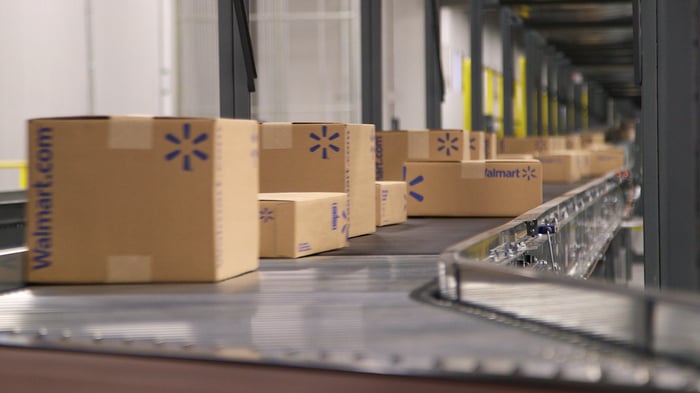Walmart (WMT 1.32%) showed considerable strength in its e-commerce operations throughout the first three quarters of its fiscal 2018. Online sales grew more than 50% year over year in each period, bolstered by the acquisitions of Jet.com and several other smaller e-commerce companies.
That's why its fourth-quarter online sales growth of 23% was so disappointing. Management said most of the decline in sales growth was expected as it lapped the Jet.com acquisition, but some of the decline was due to operational challenges. But the slowdown doesn't line up with management's prior comments that the majority of online sales growth is coming from Walmart.com and that it expects online sales growth of 40% in the upcoming fiscal year.

Image source: Walmart.
What kind of operational challenges?
When pressed for details about the operational challenges Walmart faced in its e-commerce business, CEO Doug McMillon noted the increased seasonal demand for toys and electronics made it more difficult for it to keep everyday items in stock.
That's a challenge that Walmart is capable of overcoming, and it happens to the best of them. Amazon (AMZN -1.64%), for example, experienced a difficult environment in the fourth quarter of 2015 when it saw a spike in fulfillment costs related to seasonal buying and selling trends it wasn't wholly prepared for. Amazon -- in its fashion -- sacrificed the bottom line to preserve top-line growth. Walmart took a different approach.
But Amazon has gone on to spend heavily on building out its fulfillment network in order to support continued growth. Walmart will have to do the same if it expects its investments in marketing and pricing to continue to pay off. That may be why management warned it could see even greater e-commerce losses in fiscal 2019 than last year (but it expects the operating results to be roughly the same).
Still, management didn't give us any indication about how big of a headwind these operational challenges created in the quarter versus how much came from lapsing the Jet.com acquisition. As such, the path to 40% year-over-year e-commerce sales growth this year doesn't seem as clear after the disappointing fourth-quarter results.
Management expects online grocery sales to be a key part to 2019
Back in October, management laid out its plans to add 1,000 more stores to its online grocery pickup operations this year, essentially doubling the number of stores from last year. That will take time to ramp up throughout the year, but management says that's what gives it confidence it can still reach its goal of 40% year-over-year online sales growth.
Walmart's huge network of stores is a unique asset for the brick-and-mortar retailer. It made considerable progress last year, but it still only produced about half the online grocery sales of Amazon in 2017. And while Walmart is investing in bringing on new stores to pick up from, Amazon is also investing in groceries.
Amazon started trialing two-hour grocery delivery from Whole Foods in four cities earlier this month. Delivery is free for Prime members if they order over $35 worth of food. The company is expected to expand the program quickly. Considering the prevalence of Prime in the United States, including free grocery delivery with the membership is a major threat to Walmart's in-store pickups.
Amazon isn't the only competitor in the space as other grocery retailers ramp up their online operations in order to compete. That could stymie Walmart's growth. Even if it can correct its operational problems, it's not clear where the growth will come from if not from groceries. The disappointment of the fourth quarter may be just the start of Walmart's return to sluggish online sales growth.





